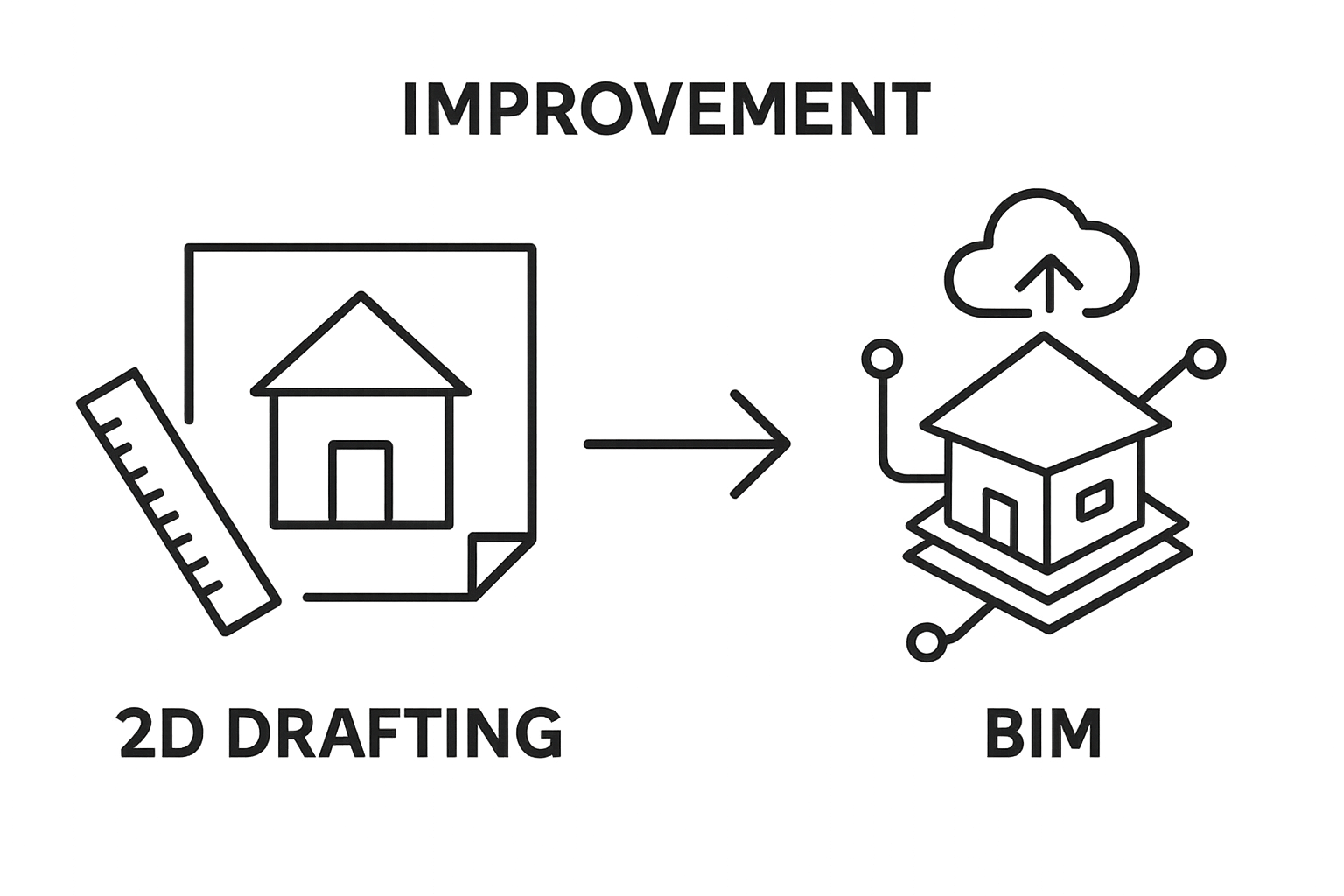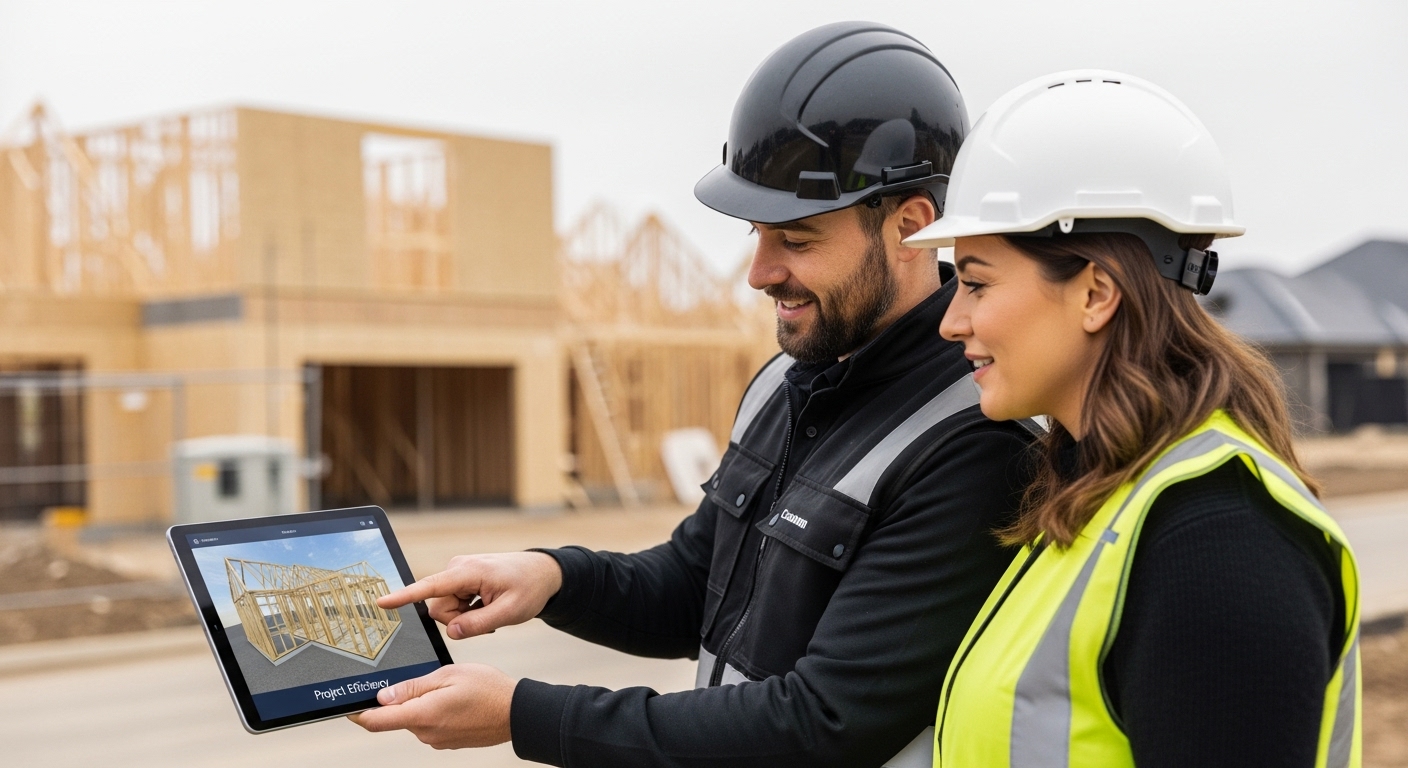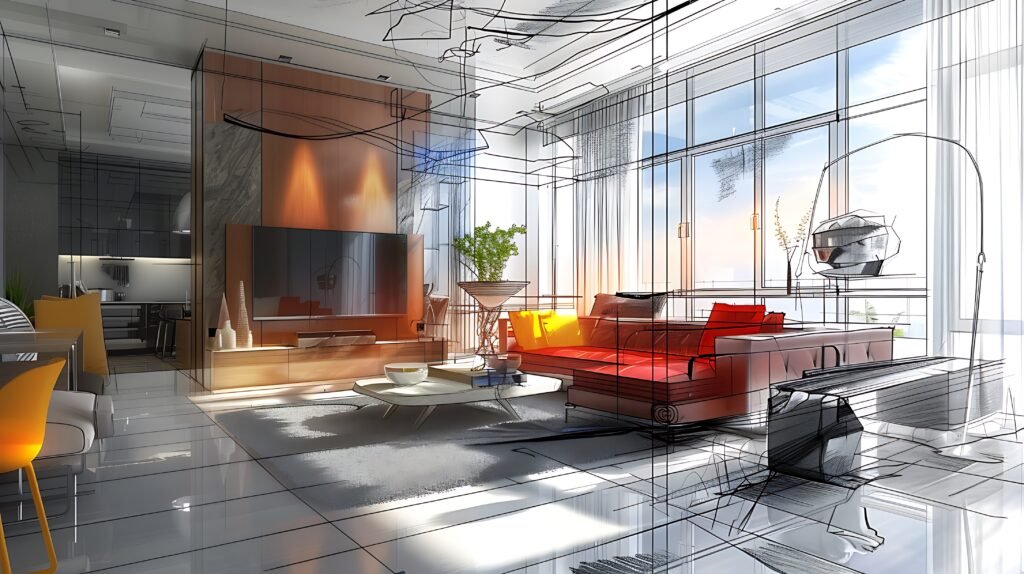
Building Information Modelling is quickly changing the way new homes are designed and built. It’s easy to think BIM is just fancier 3D drawing software for architects. Yet BIM can reduce construction costs by up to 20 percent and cut project risks by 40 percent according to leading studies, and that’s just the beginning of its impact on residential projects.
Table of Contents
- What Is BIM And Its Significance In Residential Projects?
- Why BIM Matters For Architects And Contractors In Homebuilding
- How BIM Facilitates Collaboration In Residential Construction
- Key Concepts Of BIM Technology Used In High-End Residential Projects
- The Impact Of BIM On Project Efficiency And Cost Savings
Quick Summary
| Takeaway | Explanation |
|---|---|
| BIM enhances project collaboration | BIM creates a unified digital model for all stakeholders, ensuring real-time access to accurate information and reducing miscommunication. |
| BIM improves accuracy and reduces risks | With advanced clash detection and predictive capabilities, BIM helps identify potential design conflicts, significantly lowering construction risks. |
| BIM streamlines financial management | The technology enables precise cost estimation and resource allocation, helping to optimise budgets and minimise unexpected expenses. |
| BIM enables efficient project planning | By simulating scenarios and analysing performance, BIM eases planning, allowing for informed decisions and minimising costly revisions later. |
| BIM supports enhanced design transparency | Stakeholders can visualise design scenarios and environmental impacts before construction, leading to better-informed decisions and project satisfaction. |
What is BIM and its significance in residential projects?
Building Information Modelling (BIM) represents a transformative digital approach in residential construction, fundamentally changing how architects, contractors, and developers conceptualise, design, and manage residential projects. Unlike traditional 2D drafting methods, BIM creates comprehensive digital representations of physical and functional characteristics of residential spaces.

Understanding BIM’s Core Principles
At its essence, BIM is a collaborative intelligent model that integrates multiple dimensions of architectural design and construction. It goes beyond simple geometric visualisation by embedding detailed information about every component within a residential project. Each element in a BIM model carries specific data including material specifications, cost estimates, performance characteristics, and maintenance requirements.
Key characteristics of BIM include:
- Multidimensional data representation (3D geometry, 4D scheduling, 5D cost management)
- Real-time collaboration across different project stakeholders
- Precise information management throughout project lifecycle
- Enhanced predictive capabilities for design and construction challenges
Significance in Residential Construction
The role of BIM in residential projects extends far beyond traditional design methodologies. By providing a holistic digital representation, BIM enables more accurate planning, reduces potential errors, and significantly improves project efficiency. According to McKinsey & Company, digital technologies like BIM can potentially reduce construction costs by up to 20% and shorten project timelines.
For residential developers and homeowners, BIM offers unprecedented transparency and control. The digital model allows stakeholders to visualise complex design scenarios, simulate environmental interactions, analyse energy performance, and make informed decisions before physical construction begins. This approach minimises costly design revisions and provides a clear understanding of the final product before significant financial investments are made.
To offer a clear comparison, the table below summarises how BIM stands apart from traditional residential design methods across key aspects highlighted in the article.
| Aspect | Traditional Methods | BIM Approach |
|---|---|---|
| Design Visualisation | 2D drawings, limited visual context | Comprehensive 3D and multidimensional modelling |
| Information Management | Fragmented, often siloed documents | Centralised, data-rich digital model |
| Collaboration | Communication via separate documents, risk of miscommunication | Real-time, unified model enables instant collaboration |
| Error Detection | Issues discovered during or after construction | Advanced clash detection before construction begins |
| Cost Management | Prone to estimation errors and overruns | Precise cost estimation and efficient resource allocation |
| Risk Mitigation | Reactive, post-issue adjustments | Predictive, issues anticipated and addressed in planning |
| Project Timeline | Lengthier due to reworks and coordination delays | Shortened through streamlined workflows and foresight |
Why BIM matters for architects and contractors in homebuilding
In the complex landscape of residential construction, Building Information Modelling (BIM) has emerged as a critical tool that fundamentally transforms how architects and contractors collaborate, design, and execute projects. BIM represents more than just a technological advancement – it is a comprehensive approach that reimagines traditional construction workflows.
Enhanced Collaboration and Communication
Traditional construction methodologies often suffered from fragmented communication and siloed information. BIM disrupts this paradigm by creating a unified digital environment where architects, contractors, engineers, and other stakeholders can simultaneously interact with a single, intelligent project model. This collaborative platform ensures that every professional involved has access to real-time, accurate information, dramatically reducing miscommunication and potential errors.
Key benefits of BIM collaboration include:
- Instant information sharing across project teams
- Reduced risk of design conflicts and miscommunication
- Comprehensive visibility into project progression
- Seamless integration of multidisciplinary expertise
Precision and Risk Mitigation
For architects and contractors, BIM offers unprecedented precision in design and construction planning. According to research from the Construction Industry Institute, BIM can help reduce project risks by up to 40% through advanced clash detection, detailed material quantification, and predictive simulation capabilities.
The digital model allows professionals to anticipate potential structural, mechanical, or spatial challenges before physical construction begins. This proactive approach translates into significant cost savings, minimised rework, and more efficient resource allocation. By identifying and resolving potential issues virtually, architects and contractors can streamline project timelines and maintain higher quality standards throughout the residential construction process.
How BIM facilitates collaboration in residential construction
Collaboration represents the cornerstone of successful residential construction projects, and Building Information Modelling (BIM) has revolutionised how professionals interact, share information, and coordinate complex building initiatives. BIM transforms traditional fragmented workflows into seamless, integrated processes that enable unprecedented levels of communication and coordination.
Centralised Information Ecosystem
BIM creates a dynamic, shared digital platform where architects, contractors, engineers, and other stakeholders can access and interact with a comprehensive project model. This centralised information ecosystem eliminates traditional communication barriers by providing a single source of truth that updates in real-time. Every modification, annotation, or design change becomes immediately visible to all team members, ensuring transparency and reducing potential misunderstandings.
Key collaborative advantages of BIM include:
- Simultaneous multi-user access to project information
- Instant synchronisation of design modifications
- Comprehensive tracking of project changes
- Enhanced accountability across project teams
Integrated Workflow Management
The power of BIM extends beyond simple information sharing. According to research from the Journal of Building Engineering, BIM facilitates a more integrated workflow by enabling professionals to detect potential conflicts, simulate construction sequences, and validate design parameters before physical implementation.
This integrated approach allows residential construction teams to identify and resolve potential design conflicts virtually, reducing expensive on-site modifications and streamlining project timelines. By providing a holistic view of the construction process, BIM empowers teams to make informed decisions collaboratively, ultimately delivering higher-quality residential projects with greater efficiency and precision.
Key concepts of BIM technology used in high-end residential projects
Building Information Modelling (BIM) technology represents a sophisticated digital approach that transcends traditional architectural design methodologies, particularly in high-end residential construction. BIM is not merely a visual representation but an intelligent, data-rich ecosystem that captures the intricate details of residential spaces with unprecedented precision and depth.
Multidimensional Modeling Capabilities
BIM technology extends beyond conventional 3D modeling by integrating multiple dimensions of project information. This multidimensional approach allows architects and developers to create comprehensive digital representations that encompass geometric, temporal, cost, and performance characteristics of residential spaces. Each element within the BIM model carries embedded intelligence, transforming static designs into dynamic, interactive blueprints.
Critical dimensions of BIM modeling include:
- 3D geometric visualization
- 4D time-based scheduling
- 5D cost estimation and management
- 6D sustainability performance analysis
- 7D facility management capabilities
Intelligent Information Integration
In high-end residential projects, BIM technology serves as a sophisticated information management platform. According to research published in the journal Drones, the technology enables precise coordination between architectural, structural, and mechanical systems, ensuring seamless integration of complex design elements.
The intelligent model captures intricate details about materials, performance specifications, maintenance requirements, and potential environmental interactions. This comprehensive approach allows architects and developers to simulate various design scenarios, predict potential challenges, and optimize residential spaces before physical construction begins. By providing a holistic view of the project, BIM technology empowers professionals to make data-driven decisions that enhance design quality, reduce potential risks, and deliver exceptional residential environments.
The impact of BIM on project efficiency and cost savings
Building Information Modelling (BIM) has emerged as a transformative technology that fundamentally reshapes project management and financial strategies in residential construction. Beyond traditional design approaches, BIM offers substantial improvements in operational efficiency and economic performance throughout the project lifecycle.
Reducing Project Complexity and Errors
Traditional construction methodologies often involve significant financial risks due to design conflicts, miscommunication, and unexpected complications. BIM mitigates these challenges by providing a comprehensive, integrated digital environment that allows stakeholders to identify and resolve potential issues before physical construction begins. This proactive approach dramatically reduces costly rework and unexpected modifications during the construction phase.
Key efficiency improvements include:
- Early detection of design conflicts
- Precise material quantification
- Reduced on-site rework
- Enhanced predictive planning capabilities
- Streamlined communication across project teams
Financial Impact and Cost Optimization
According to research from the National Institute of Standards and Technology, BIM technologies can generate substantial economic benefits by improving project coordination and reducing inefficiencies. The technology enables more accurate cost estimation and resource allocation, allowing developers to optimize budgets and minimize unexpected financial overruns.
By providing real-time data and advanced simulation capabilities, BIM empowers residential construction teams to make informed decisions that directly translate into tangible cost savings.
The following table condenses key statistics and research findings from the article, highlighting BIM’s measurable impact on residential construction projects.
| Metric / Finding | Reported Value | Source Agency / Study |
|---|---|---|
| Potential reduction in construction costs | Up to 20% | McKinsey & Company |
| Project risk reduction | Up to 40% | Construction Industry Institute |
| Project timeline reduction | Not specified, can be shortened | McKinsey & Company |
| Economic benefit from improved coordination | Substantial | National Institute of Standards and Technology |
| Cost savings through clash detection and planning | Significant | Construction Industry Institute |

Transform Digital Design into Reality with Intelligent BIM Solutions
Are you struggling to achieve clarity and coordination in your residential projects because of traditional design methods and disjointed communication? The article shows how fragmented workflows and limited data sharing often lead to costly errors, delays, and uncertain outcomes. By exploring BIM’s multidimensional modelling and collaborative capabilities, you can overcome challenges like miscommunication, inefficient planning, and unexpected costs.
Let Reltic BIM help you turn these insights into real world results. Our London-based consultancy offers comprehensive Building Information Modelling services for high-end residential developments, using advanced BIM coordination, detailed 3D and 4D modelling, cost estimation, and digital handover that aligns with global standards. Discover how we support architects, contractors, and investors by delivering seamless projects on time and within budget. Do not let outdated processes hold your vision back. Explore Reltic BIM today and see how digital innovation can transform your next project from design to delivery. Ready for a clearer, smarter approach? Get in touch now to start building with greater confidence.
Frequently Asked Questions
What is Building Information Modelling (BIM)?
Building Information Modelling (BIM) is a digital approach in residential construction that creates comprehensive digital representations of the physical and functional characteristics of residential spaces, integrating multiple dimensions such as geometry, scheduling, cost, and performance.
How does BIM enhance collaboration in residential projects?
BIM fosters a collaborative digital environment where architects, contractors, engineers, and other stakeholders can access a unified project model in real-time, significantly reducing miscommunication, design conflicts, and enhancing overall project coordination.
What are the cost-saving benefits of using BIM in residential construction?
BIM can lead to substantial cost savings by improving project coordination, accurately estimating costs, and reducing errors. Research indicates that BIM can reduce construction costs by up to 20% and minimise unexpected financial overruns by facilitating better planning and resource allocation.
How does BIM contribute to risk mitigation in homebuilding?
BIM enhances precision in design and project planning by allowing for advanced clash detection and predictive simulation, which helps identify potential structural or spatial issues before construction begins. This proactive approach reduces the risk of costly rework and keeps project timelines on track.


